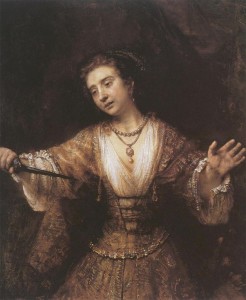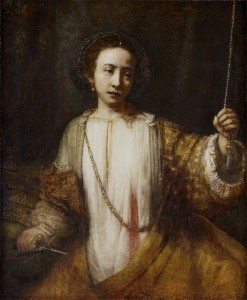Amanda Lesnikowski is a senior art history major who will graduate in May 2013. Her senior paper and presentation, on Rembrandt’s paintings of Lucretia, was presented at a research conference at Baker University in Kansas and a symposium at the Minneapolis Institute of Arts. Her senior presentation will be on May 17.
When the senior paper began popping up in conversations about a year ago, everyone kept telling me not to “reinvent the wheel.” At the end of my junior year, I knew that I wanted to elaborate on a paper I had already written, but I was not sure what that paper would be. During the fall 2012 semester I was enrolled in Robert Ferguson’s Baroque and Rococo course. We were required to choose a work from the Minneapolis Institute of Arts and use it as the basis for all of our research. Portraits having a special place in my heart, I claimed Rembrandt’s 1666 Lucretia. The semester went quickly, and my final paper only left me with more questions and bigger ideas than answers.
It was at this point that both Robert and I knew this paper had more potential than just a final classroom essay. After asking him to be my advisor, we began brainstorming what new questions we wanted to answer. This process left us with two areas of study: theatricality and family in Rembrandt’s two Lucretias (see images below). Rembrandt is known by scholars as having included great amounts of theater into his paintings, whether it be live gestures, the implication of speech, or even his application of lighting. When it came to family, Rembrandt had a very colored history. He saw his family as one of the most important parts of his life, and it was often seen in his art.
Through further research, we discovered another important part of Rembrandt’s art: the tronie. A tronie, a Dutch word for face, is used as a term to describe a combination of portraiture and history painting. Here is an excerpt of my paper detailing Rembrandt’s invention:
Rembrandt “combined theory and practice” and invented the “tronie,” a combination of portraiture and history painting.(1) Martha Hollander spoke highly of the seventeenth-century, Dutch history painting. She explains the genre’s power and the ability to move an audience: “History painting was an opportunity to tell a story on a grand scale, combining anecdotal and archaeological details with displays of eroticism, violence, and powerful emotion. Successful compositions required strong stage-managing skills.”(2) As seen in these two portraits of Lucretia, the background is bare, almost completely faded to black. Hollander attributes this to Rembrandt’s style: “Rembrandt’s method, demonstrated in his history paintings [. . .], is to imply, rather than describe, a space.”(3) This pushes the actor, or subject, to the front of the stage. Rembrandt clearly saw his studio as a stage, where the model’s purpose was to perform.(4)
Rembrandt’s depiction of St. Bartholomew is a wonderful example of the tronie (see below). The painting, from 1661 and now at the J. Paul Getty Museum, is apparently a character study, but is converted into a history painting by adding a single prop: the knife. Rembrandt uses the prop to bring the audience full circle. The knife allows the audience to complete a mental image, one of a man everyone knows. Without the knife, this would just be a portrait, albeit of a particular person. The man in the painting gazes out towards his audience with a look of contemplation. Holding his head in his left hand, his emotions are hard to classify. His look of self-reflection is a feeling anyone could relate to. Like the Lucretias, Rembrandt’s lighting emphasizes the subject’s face. It is here that the viewer is drawn first, and only then, down his right arm and along the draped fabric where they observe that he is holding a knife. Now they identify that this man is St. Bartholomew, the martyr who was skinned alive.
Writing this paper has taught me how to be a better art historian, a stronger writer, and a more eloquent speaker. I have had the opportunity to present my paper three times: at the ACTC and Minneapolis Institute of Arts (MIA) symposium, at the Baker University Art History Conference, and at the St. Thomas undergraduate symposium. I was honored to be asked to speak at the ACTC/MIA and represent St. Thomas. I am so grateful that the department chose me. I heard of the Baker University conference through a department e-mail. I sent in a five hundred word abstract and title, then a few weeks later heard I was chosen to speak. I traveled to Kansas at the end of April to present along with other undergraduate researchers.
The undergraduate symposium at St. Thomas is also a celebration as well as a presentation. It is a wonderful opportunity to show your peers and professors what you have been working on the past year, and to hear your friends speak and to get their opinion on your own work.
Research always brings more questions than it does answers, but, hopefully, your own paper is able to answer someone else’s question. Attending these symposiums has been inspiring, humbling, and exciting, but they have prepared me for my next steps as an art historian.
NOTES
(1) Simon Schama, Rembrandt’s Eyes (New York, 1999), 660-663.
(2) Martha Hollander, An Entrance for the Eyes: Space and Meaning in Seventeenth-Century Dutch Art (Berkley, 2002), 16.
(3) Hollander, 67.
(4) Svetlana Alpers, Rembrandt’s Enterprise (Chicago, 1988), 58.


